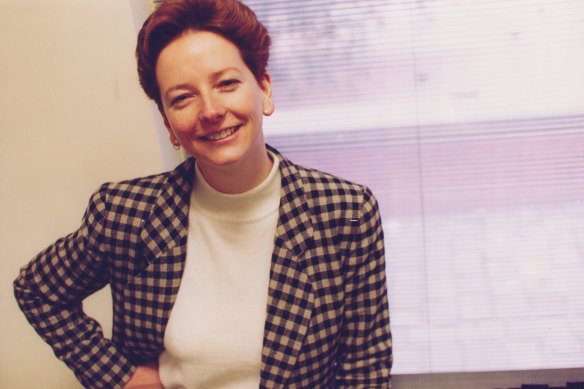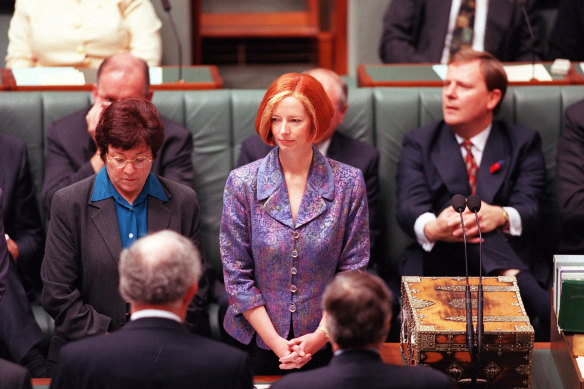This was published 9 months ago
Julia Gillard on the vote that has reshaped parliament for 30 years
By David Crowe
Some votes can be passed with murmurs of assent, and some with shouts of dismay. But three decades ago this month, women welcomed a historic vote at the Labor National Conference by rushing to the floor and dancing for joy.
The vote in Hobart in 1994 changed the party, and the country, by setting an affirmative action target to get more women elected to parliament. Julia Gillard joined her friends that day by busting a move on the conference floor.

Julia Gillard in 1994, the year of the Hobart convention.Credit: Ken Irwin
“I’d have to say my dancing is not that elegant, so I was, perhaps, not the most exuberant of the people dancing,” the former prime minister says. “But I was absolutely delighted that finally, finally, finally, we passed the rule at the national conference.”
The rule turned into a live experiment in bringing more women into the nation’s biggest decisions. It required Labor to make sure 35 per cent of its candidates were women – and it was fiercely opposed by powerbrokers who thought the quota would slam the door on men.
The Labor caucus will mark the anniversary in Parliament House on Monday night by hearing from Prime Minister Anthony Albanese, Environment Minister Tanya Plibersek and Minister for Women Katy Gallagher.
Gillard, who worked with former Victorian premier Joan Kirner to get the numbers in 1994, says it took years of campaigning to win.

Julia Gillard enters parliament in 1998.Credit: Mike Bowers
“There were people who thought we didn’t need this, that it was too much of a distortion to how we thought about preselections, that it would take us away from potentially preselecting the best candidates, that it would therefore prejudice our electoral chances,” she says.
“But without affirmative action, I really don’t think we would have seen the big drives that we have seen on issues like paid parental leave, the gender pay gap, childcare.
“And that isn’t to say that women go into parliament just to advocate on work and family life issues. Women obviously go in to advocate on the broad sweep of issues, from the economy and defence – the broad sweep of issues. Women bring a diversity of lived experience. They can contribute that to the policy discussions.”
The major unions were on board with the change, because many already had affirmative action targets, and the reform had support from Labor women including Sharan Burrow, Jennie George, Candy Broad, Kay Setches, Jenny Beacham, Jeannette McHugh and Sheila O’Sullivan.
Crucially, Paul Keating backed the new rule as prime minister.
“His decision to support the reform was absolutely pivotal,” says Gillard. “He was prepared to stare down others who weren’t supportive.”
Soon after the vote, a journalist asked Keating if he had any sympathy for men who might miss out on getting into parliament.
He replied: “Well, I think, by and large, the men, as you put it, have had more than their share of the market for most of the century, so I don’t think feeling sorry for them is quite the term.”
Labor followed the 35 per cent rule with a 40 per cent goal and, finally, a 50 per cent target at the party’s conference in Melbourne nine years ago. Labor caucus chair Sharon Claydon, who campaigned for the 50 per cent target and will chair the event on Monday night, says the party exceeded each target sooner than expected.
Plibersek, who witnessed the vote in 1994 and joined the dancing, says she has not seen such a moment of celebration at a Labor conference before or since.
“It changed the party and it changed the country,” she says. “What had seemed impossible actually became expected – that we would be a party that better reflected the whole of the Australian population.”
For Penny Wong, who was an observer at the Hobart conference as a young industrial officer at the time, the vote was not only about getting more women preselected but also changing the culture of the party. The foreign minister says the outcome is reflected today in the number of women in senior positions, including the cabinet and ministry.
Opponents of the Labor rule have argued for decades that quotas are flawed. The Liberal Party has policies to encourage women into parliament but does not enforce a numerical goal, although former Liberal MP Sharman Stone called a decade ago for an official target.
The Parliamentary Library calculates that women make up 52.4 per cent of the Labor caucus and 29.2 per cent of the Liberal party room. They make up 28.6 per cent of the Nationals in federal parliament and 53.3 per cent of the Greens.
Gillard says the numbers provide a “scoreboard” to prove the rule change worked because Labor and the Liberals both had about 14 per cent women in 1994.
“When we look at the other side of politics, they always said that they wouldn’t do an affirmative action rule, that they would try other mechanisms to encourage women, and that largely hasn’t worked,” she says.
“You know, their statistics have gone up from the same 14 per cent but have only got to 28 per cent – so, you know, it’s actually a perfect policy experiment in many ways. Other interventions, like mentoring and women’s networking events, slowly haul you up to a rate like 28 per cent. But it’s affirmative action, the rule, that takes you over the top and gets you to 50 per cent.”
Cut through the noise of federal politics with news, views and expert analysis. Subscribers can sign up to our weekly Inside Politics newsletter.